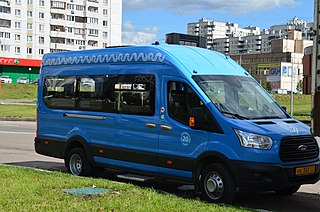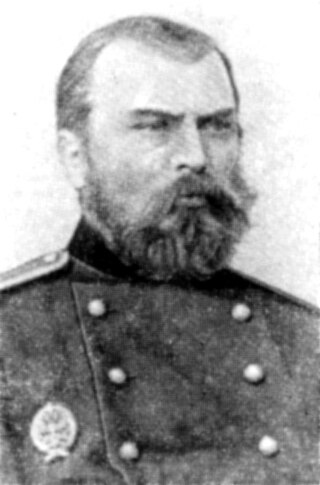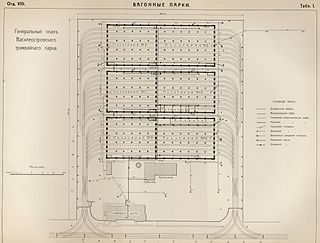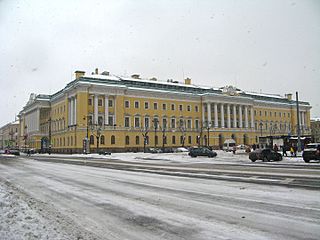Exhibits
The museum's collection includes 45 trams and 18 trolleys.
 |  |  |  |
| Model "МБ"-vehicle by Brush | Semished 4 | Track-test car LM-57 | LM-49 |
The Museum of Electrical Transport is located on Vasilyevsky Island in Saint Petersburg, Russia.
The museum was established in 1967, and is the oldest museum of electrical transport in Russia.[ citation needed ] It is based at the old Vasileostrovsky tram depot in Saint Petersburg which was built in 1906–1908.[ citation needed ] To celebrate the 90th anniversary of the St. Petersburg tram, examples of the trams that have been used in St. Petersburg have been restored. There are also static exhibits: archival documents and photos, cards, breadboard models of horsecars and trams, examples of tram worker uniforms, and original cash registers. On 21 May 2011, the museum took part in the Long Night of Museums event for the first time [1]
The museum's collection includes 45 trams and 18 trolleys.
 |  |  |  |
| Model "МБ"-vehicle by Brush | Semished 4 | Track-test car LM-57 | LM-49 |
There are plans to construct a "Palace of arts" and various commercial ventures on part of the museum's site. The project has caused mass protest from the local community. [2] [3] All models of tramways and trolleybuses are available on the official site of the Centre of events in the Tramways of Saint Petersburg - event-tram.ru

A tram is a type of urban rail transit. It consists of a rail vehicle, either alone or coupled in a multiple train unit, traveling on tramway tracks on public urban streets; some include segments on segregated right-of-way. The tramlines or networks operated as public transport are called tramways or simply trams/streetcars. Many recently built tramways use the contemporary term light rail.

Pushkin is a municipal town in Pushkinsky District of the federal city of St. Petersburg, Russia, located 24 kilometers (15 mi) south from the center of St. Petersburg proper, and its railway station, Tsarskoye Selo, is directly connected by railway to the Vitebsky Rail Terminal of the city. Population: 92,889 (2010 Census).

Vasilyevsky Island is an island in St. Petersburg, Russia, bordered by the Bolshaya Neva and Malaya Neva Rivers in the south and northeast, and by Neva Bay of the Gulf of Finland in the west. Vasilyevsky Island is separated from Dekabristov Island by the Smolenka River. Together they form the territory of Vasileostrovsky District, an administrative division of Saint Petersburg.

Marshrutka or marshrutnoe taksi or routed taxicab, are share taxis found in Eastern Europe and the republics of the former Soviet Union. Usually vans, they drive along set routes, depart only when all seats are filled, and may have higher fares than buses. Passengers can board a marshrutka anywhere along its route if there are seats available.

Palace Square, connecting Nevsky Prospekt with Palace Bridge leading to Vasilievsky Island, is the central city square of St Petersburg and of the former Russian Empire. Many significant events took place there, including the Bloody Sunday massacre and parts of the October Revolution of 1917. Between 1918 and 1944, it was known as Uritsky Square, in memory of the assassinated leader of the city's Cheka branch, Moisei Uritsky.

Trams in Saint Petersburg are a major mode of public transit in the city of Saint Petersburg, Russia. Saint Petersburg once had the second-largest tram network in the world, consisting of about 340 kilometres (210 mi) of unduplicated track in the late 1980s. However, since 1995 the tramway network has declined sharply in size as major portions of track were removed, particularly in the city centre. Saint Petersburg lost its record to Melbourne, Australia. While it still had 285 kilometres (177 mi) of length in 2002, by early 2007 the tram network's had declined to just over 220 kilometres (140 mi), and by the 2010s operated on just 205.5 kilometres (127.7 mi) of network.


The Alexander Column, also known as Alexandrian Column, is the focal point of Palace Square in Saint Petersburg, Russia. The monument was raised after the Russian victory in the war with Napoleon's France. The column is named for Emperor Alexander I of Russia, who reigned from 1801 to 1825.

Fyodor Apollonovich Pirotsky, or Fedir Apollonovych Pirotskyy was a Russian engineer of Ukrainian ancestry, inventor of the world's first railway electrification system and electric tram While the commercialization of his inventions in the Russian Empire was relatively slow, Pirotsky is known to have met with Carl Heinrich von Siemens and influenced Siemens' eventual introduction of the first regular electric tram line.

St. Petersburg is a major trade gateway, financial and industrial center of Russia specialising in oil and gas trade, shipbuilding yards, aerospace industry, radio and electronics, software and computers; machine building, heavy machinery and transport, including tanks and other military equipment, mining, instrument manufacture, ferrous and nonferrous metallurgy, chemicals, pharmaceuticals, medical equipment, publishing and printing, food and catering, wholesale and retail, textile and apparel industries, and many other businesses.
Petersburg Tram Mechanical Factory (PTMF) was one of the leading manufacturers of tramcars in Russia and the CIS-countries located in Saint Petersburg. As the only tram manufacturing plant in Russia for several decades, it was the sole supplier of rolling stock for the tram system in St. Petersburg.

Petrogradsky Island or Petrograd Island is the third-largest island in the Neva River delta in Saint Petersburg, Russia. Along with Zayachy Island, Aptekarsky Island, and Petrovsky Island, it constitutes the Petrogradskaya Side. It is the administrative center of the Petrogradsky District and hosts a number of universities and research centers, as well as cultural, historical, and recreational facilities.

Saint Petersburg, formerly known as Petrograd (1914–1924) and later Leningrad, is the second-largest city in Russia after Moscow. It is situated on the Neva River, at the head of the Gulf of Finland on the Baltic Sea. The city had a population of roughly 5.6 million residents as of 2021. Saint Petersburg is the fourth-most populous city in Europe, the most populous city on the Baltic Sea, and the world's northernmost city of more than 1 million residents. As Russia's Imperial capital, and a historically strategic port, it is governed as a federal city.

Vasileostrovsky tram depot is the oldest tram depot in Saint Petersburg. It was built in 1906 - 1908 by Westinghouse Electric. Vasileostrovsky trampark is a shrine for citizens, because it is associated with the unprecedented feat of Leningrad during World War II against Nazi Germany. Today the Museum of electrical transport is located there.


Grand Maket Rossiya is a private museum in Saint Petersburg, Russia. It is a model layout designed on a scale of 1:87 and covers an area of 800 m2 (8,600 sq ft). In this area, collective images of regions of the Russian Federation are represented. It is the largest model layout in Russia and the second largest in the world. The model is located in a two-story building built in 1953, in the style of Stalin’s empire. The creator of the project is a Saint Petersburg businessman Sergey Morozov.

Saint Petersburg – second-largest city in Russia. An important Russian port on the Baltic Sea, it has the status of a federal subject. Its name was changed to "Petrograd" in 1914, then to "Leningrad" in 1924, and back to Saint Petersburg in 1991.

The Arts Square is an open public square in the center of Saint Petersburg, Russia.